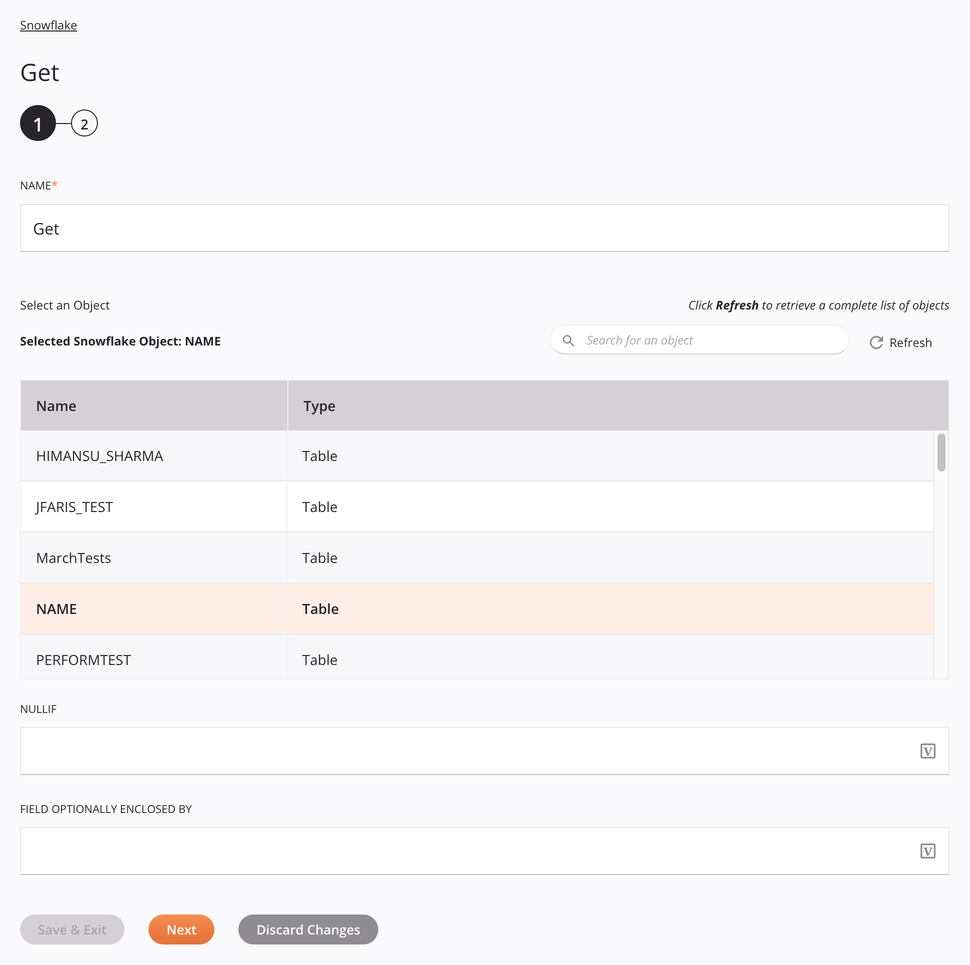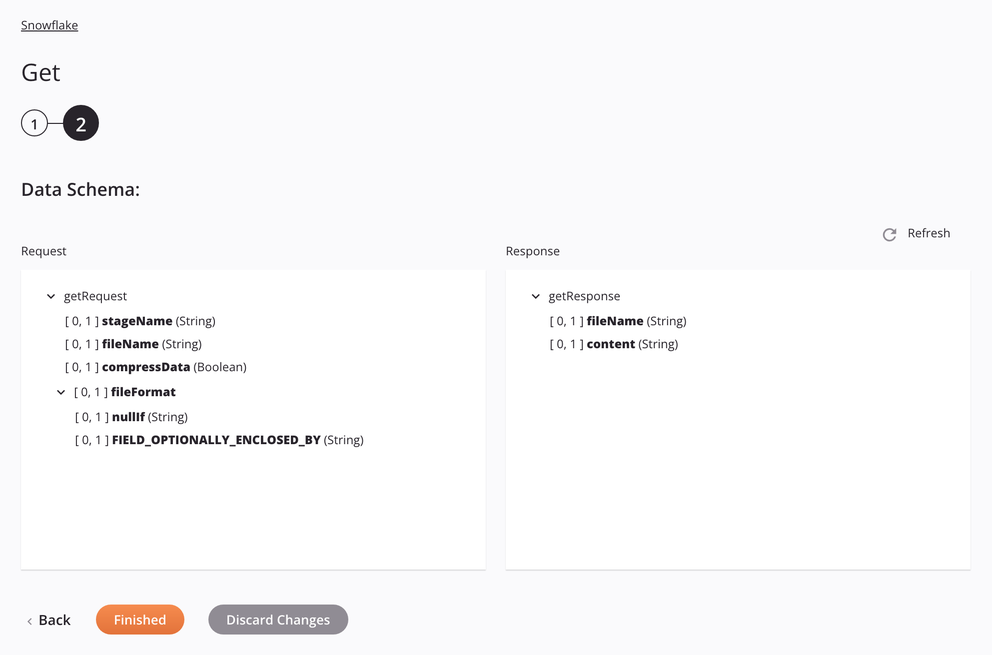Snowflake Get activity¶
Introduction¶
A Snowflake Get activity, using its Snowflake connection, retrieves a CSV file of table or view data from Snowflake and is intended to be used as a source to provide data in an operation.
Note
Depending on your Snowflake permissions, the Get activity will return only data that you have access to. For example, if you have permissions only for view data, then the Get activity will return only view data and will not return table data.
Create a Snowflake Get activity¶
An instance of a Snowflake Get activity is created from a Snowflake connection using its Get activity type.
To create an instance of an activity, drag the activity type to the design canvas or copy the activity type and paste it on the design canvas. For details, see Creating an activity instance in Component reuse.
An existing Snowflake Get activity can be edited from these locations:
- The design canvas (see Component actions menu in Design canvas).
- The project pane's Components tab (see Component actions menu in Project pane Components tab).
Configure a Snowflake Get activity¶
Follow these steps to configure a Snowflake Get activity:
-
Step 1: Enter a name and select an object
Provide a name for the activity and select an object, either a table or a view. -
Step 2: Review the data schemas
Any request or response schemas generated from the endpoint are displayed.
Step 1: Enter a name and select an object¶
In this step, provide a name for the activity and select a table or view (see Snowflake's Overview of Views). Each user interface element of this step is described below.

Tip
Fields with a variable icon ![]() support using global variables, project variables, and Jitterbit variables. Begin either by typing an open square bracket
support using global variables, project variables, and Jitterbit variables. Begin either by typing an open square bracket [ into the field or by clicking the variable icon to display a list of the existing variables to choose from.
-
Name: Enter a name to identify the activity. The name must be unique for each Snowflake Get activity and must not contain forward slashes
/or colons:. -
Select an Object: This section displays objects available in the Snowflake endpoint. When reopening an existing activity configuration, only the selected object is displayed instead of reloading the entire object list.
-
Selected Snowflake Object: After an object is selected, it is listed here.
-
Search: Enter any column's value into the search box to filter the list of objects. The search is not case-sensitive. If objects are already displayed within the table, the table results are filtered in real time with each keystroke. To reload objects from the endpoint when searching, enter search criteria and then refresh, as described below.
-
Refresh: Click the refresh icon
 or the word Refresh to reload objects from the Snowflake endpoint. This may be useful if objects have been added to Snowflake. This action refreshes all metadata used to build the table of objects displayed in the configuration.
or the word Refresh to reload objects from the Snowflake endpoint. This may be useful if objects have been added to Snowflake. This action refreshes all metadata used to build the table of objects displayed in the configuration. -
Selecting an Object: Within the table, click anywhere on a row to select an object. Only one object can be selected. The information available for each object is fetched from the Snowflake endpoint:
-
Name: The name of an object, either a table or a view.
-
Type: The type of the object, either a table or a view.
-
Tip
If the table does not populate with available objects, the Snowflake connection may not be successful. Ensure you are connected by reopening the connection and retesting the credentials.
-
-
NullIf: The value to be returned if a result is
NULL. -
Field Optionally Enclosed By: The optional character used to enclose the NullIf field.
-
Save & Exit: If enabled, click to save the configuration for this step and close the activity configuration.
-
Next: Click to temporarily store the configuration for this step and continue to the next step. The configuration will not be saved until you click the Finished button on the last step.
-
Discard Changes: After making changes, click to close the configuration without saving changes made to any step. A message asks you to confirm that you want to discard changes.
Step 2: Review the data schemas¶
Any request or response schemas generated from the endpoint are displayed. Each user interface element of this step is described below.

-
Data Schemas: These data schemas are inherited by adjacent transformations and are displayed again during transformation mapping.
Note
Data supplied in a transformation takes precedence over the activity configuration.
The Snowflake connector uses the Snowflake JDBC Driver and the Snowflake SQL commands. Refer to the API documentation for information on the schema nodes and fields.
The request and response data schemas consist of these nodes and fields:
-
Request
Request Schema Field/Node Notes stageNameName of the internal Snowflake stage used while getting table data. Note
The
stageNameis the name of an internal Snowflake staging area, which needs to be pre-existing before running an operation using this activity. The file is first copied to the staging area before it is available to the connector.fileNameName of the file on the internal Snowflake stage to be used while getting table data. compressDataBoolean flag for whether to compress the data before uploading it to the internal Snowflake stage. fileFormatNode of the file format. nullIfDisplay value for NULLIF.FIELD_OPTIONALLY_ENCLOSED_BYDelimiter used to enclose the NULLIFentry. -
Response
Response Schema Field/Node Notes fileNameName of the file on the internal Snowflake stage used while getting table data (identical to request). contentContent of the Snowflake table in CSV format.
-
-
Refresh: Click the refresh icon
 or the word Refresh to regenerate schemas from the Snowflake endpoint. This action also regenerates a schema in other locations throughout the project where the same schema is referenced, such as in an adjacent transformation.
or the word Refresh to regenerate schemas from the Snowflake endpoint. This action also regenerates a schema in other locations throughout the project where the same schema is referenced, such as in an adjacent transformation. -
Back: Click to temporarily store the configuration for this step and return to the previous step.
-
Finished: Click to save the configuration for all steps and close the activity configuration.
-
Discard Changes: After making changes, click to close the configuration without saving changes made to any step. A message asks you to confirm that you want to discard changes.
Next steps¶
After configuring a Snowflake Get activity, complete the configuration of the operation by adding and configuring other activities, transformations, or scripts as operation steps. You can also configure the operation settings, which include the ability to chain operations together that are in the same or different workflows.
Menu actions for an activity are accessible from the project pane and the design canvas. For details, see Activity actions menu in Connector basics.
Snowflake Get activities can be used as a source with these operation patterns:
- Transformation pattern
- Two-target archive pattern (as the first source only)
- Two-target HTTP archive pattern (as the first source only)
- Two-transformation pattern (as the first or second source)
To use the activity with scripting functions, write the data to a temporary location and then use that temporary location in the scripting function.
When ready, deploy and run the operation and validate behavior by checking the operation logs.